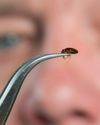
What exactly is a corvid?
Dr Kaeli Swift Corvids are a kind of songbird. Corvids, so the Corvidae family, includes crows, ravens, magpies, jays, rooks, jackdaws and choughs. Ravens are the biggest songbird in the world.
They’re songbirds? But a crow makes a ‘caw caw caw’ noise, which sounds pretty different from other birds.
‘Songbird’ is a little bit of a tricky name because the designation of songbird is based on both the positioning of the feet and, most importantly, the anatomy of the vocal area. And that’s the feature that these birds share with birds like robins and sparrows and all that kind of thing.
Humans produce the sounds that we do using a larynx, and most birds, including songbirds, have what’s called a syrinx. The anatomy does differ a little bit across groups, but the corvid syrinx is going to look pretty similar to other kinds of songbirds. The main difference, though, between crows and ravens and other types of songbirds has less to do with their anatomy and more to do with their brain. Most songbirds have a short window of time when they’re young where they learn every sound that they’re going to make, then that window closes, and that’s it. They don’t make any changes moving forward. But one of the interesting aspects about crows and ravens is that they can learn new sounds throughout their lives. They have really impressive vocal repertoires. Part of the reason that they can make such a wide variety of sounds, including human speech, is because they have independent muscle control on either side of their syrinx, so they can produce two different sounds at the same time.
This story is from the {{IssueName}} edition of {{MagazineName}}.
Start your 7-day Magzter GOLD free trial to access thousands of curated premium stories, and 9,000+ magazines and newspapers.
Already a subscriber ? Sign In
This story is from the {{IssueName}} edition of {{MagazineName}}.
Start your 7-day Magzter GOLD free trial to access thousands of curated premium stories, and 9,000+ magazines and newspapers.
Already a subscriber? Sign In

TAKE IT SLOW
Slow running is a fitness trend with some hard and fast science behind it

Physics, AI and music share a common thread. You just have to know where to look
Studying science can lead you in many directions and open doors to unexpected possibilities along the way

BED BUGS VS THE WORLD
When bloodthirsty bed bugs made headlines for infesting Paris Fashion Week in 2023, it shone a spotlight on a problem that's been making experts itch for decades: the arms race going on between bed bugs and humans

Kids are the key to understanding obesity. But we need more of their genes...
We can unravel the role that bodyweight plays in disease, but we need a bigger, more diverse, sample of genetic material to do so

COVID inquiry: What did we learn and what can we do better in future pandemics?
Masks, social distancing, lockdowns... how effective was the UK's response to the COVID-19 pandemic?

One hormone could be the key that unlocks a cure for morning sickness
The nausea and vomiting that, in extreme cases, can endanger mothers and babies might soon be just a memory

THE WORLD'S WEIRDEST CREATURES
Under the sea and upon the land, some animals look - to us - pretty strange...

WHEN MIND AND MACHINE COLLIDE
First, Elon Musk wanted to make electric cars ubiquitous, then he wanted to make space exploration a private enterprise. Now, with Neuralink, his newest venture, Musk hopes to merge humans and artificial intelligence. Turns out, it might not be such a crazy idea...

COME OUT OF YOUR SHELL
Social anxiety is more than just being shy. It's a phobia born out of our evolutionary past. But that raises a puzzling question: why do so many of us fear human interaction when we're supposed to be the most sociable species on the planet?

SPACE ODDITIES
Take a tour of the weirdest spots in the universe, where the 'normal' rules don't apply. Places that squeeze time, blow bubbles and even rain glass... sideways